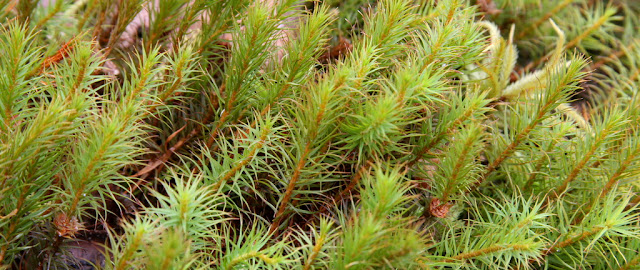Why blog about moss?
1. I've recently taken up a keen interest in mosses. Recently as in over the last two years. Well, a very slowly developing interest the first year and then an all-encompassing, sleepless obsession this past year.
2. I wanted to use this opportunity to make people see the cool things they are missing when they are not paying attention to mosses.
3. Why not?
 |
| Apple Moss (Bartramia pomiformis) with young sporophytes |
Of course, I am going to start off this blog with "What is a moss?", why wouldn't I? Well, mosses are Bryophytes, aka non-vascular plants. Mosses have structures that appear to be leaves, however, these leaves are simply single sheets of cells lacking all of the complexity of the true leaves of vascular plants, aka Tracheophytes, aka that straggling rose outside your window. With only a simple layer of cells acting as a "leaf", mosses are unable to control water loss from their tissues and shrivel up into obscure crisp nothings at the slightest hint of a dry day. That's okay though, mosses are poikilohydric! This means that mosses are able to withstand severe dehydration and recover as if nothing happened once moisture returns.
When you finally decide to look at a moss, you are typically seeing the gametophyte stage; the green plant-looking part. In this stage, the moss does photosynthesize like normal plants, but it lacks true roots and does not take up water like normal plants. The more inconspicuous portion of a moss is the sporophyte. Sporophytes slowly emerge from the gameotophytes and their tips swell into capsules full of spores. It is by these spores that mosses reproduce. Both of these stages can be vital to properly identifying a moss and both stages can be equally interesting to look at.
Anyways, on to the the "making people see the cool things they are missing when they are not paying attention to mosses" part of the blog. Lets start with some of the gameotophytes.
 |
| Juniper Moss (Polytrichum juniperinum), like tiny juniper trees |
 |
| Climacium americanum looks like tiny palm trees |
 |
| This too is a moss, Fern Moss (Thuidium sp.), of course |
 |
| The coppery sheen and clasping, spoon-like leaves distinguish Spoon-leaved Moss (Bryoandersonia illecebra) |
 |
| The whitish, translucent leaf tips and in-rolled leaf margins help ID this Pincushion moss (Leucobryum sp.) |
And not all mosses are lucious and green, check out these species growing on rocks.
 |
| Black tufts on a limestone face? |
 |
| Scratchy, grey carpet on sandstone? |
Yep, both of those are mosses, check out the close-ups...
 |
| Strangulate Moss (Orthotricum strangulatum) with example sporophyte |
 |
| Dry Rock Moss (Grimmia laevigata) |
How about a few moss fun-facts?
1. There are approximately 12,000 species of classified mosses!
2. The term bryophyte apparently comes from the Greek bryo, "moss" and phyte "plant". Hm, mossplant, how redundant.
3. Mosseries! Apparently, collecting moss was a fad in the late 19th century. Mosseries were flat-roofed boxes open at the northern end to maintain a shaded environment for moss samples that were inserted between the slats of wood. Regularly moistened mosseries were a typical installment in British and American gardens during this time.
Alright so what about those sporophytes I mentioned earlier? Many can be quite cool and bizarre looking. Some mosses can only be certainly ID'd with the sporophyte present.
 |
| Some sporophytes are large and hard to miss, like these from the Juniper Moss I showed previously. Here you see one of the younger sporophytes still bearing its hairy sheath. Hence, the other common name "Juniper Hairy-cap Moss". |
 |
| And, of course, there are tiny, easily missed sporophytes like these from Velvet Apron Moss (Anamodon rostratus) |
 |
| Some sporophytes look like alien cyclops peaking out of the moss, like these mostly mature examples from Bartramia pomiformis |
 |
| These pear-shaped sporophytes are known for showing up after burns or around old abandoned campfire spots, here is Cinderella Moss (Funaria hygrometrica) |
 |
| Woodsy Moss (Mnium sp.), a pretty common group, can sport these brightly colored, drooping cylinders. |
Now that you are thoroughly enthused about getting outside and paying attention to mosses (even if you have to get really close to the ground and dirty up your knees), I will leave you with some tremendously helpful texts on moss identification that, for the most part, utilize direct observation of the specimen or, at the most, the use of a good hand lens. Many species require microscopic examination of the "leaf" cells and/or spores.
Happy Mossing!
Outstanding Mosses and Liverworts of Pennsylvania and Nearby States
Walk Softly Upon the Earth: A Pictorial Field Guide to Missouri Mosses, Liverworts and Lichens Apparently I got the last copy of this text that wasn't near $100 on Amazon. Not worth that amount, but useful if you can find it. A handful of typos and necessary corrections in the text. I have all of those if you happen upon a copy.
Mosses With a Hand Lens: A Non-technical Handbook of the More Common and More Easily Recognized Mosses of the Northeastern United States
A Trailside Guide to Mosses and Liverworts of the Cherokee National Forest



















































